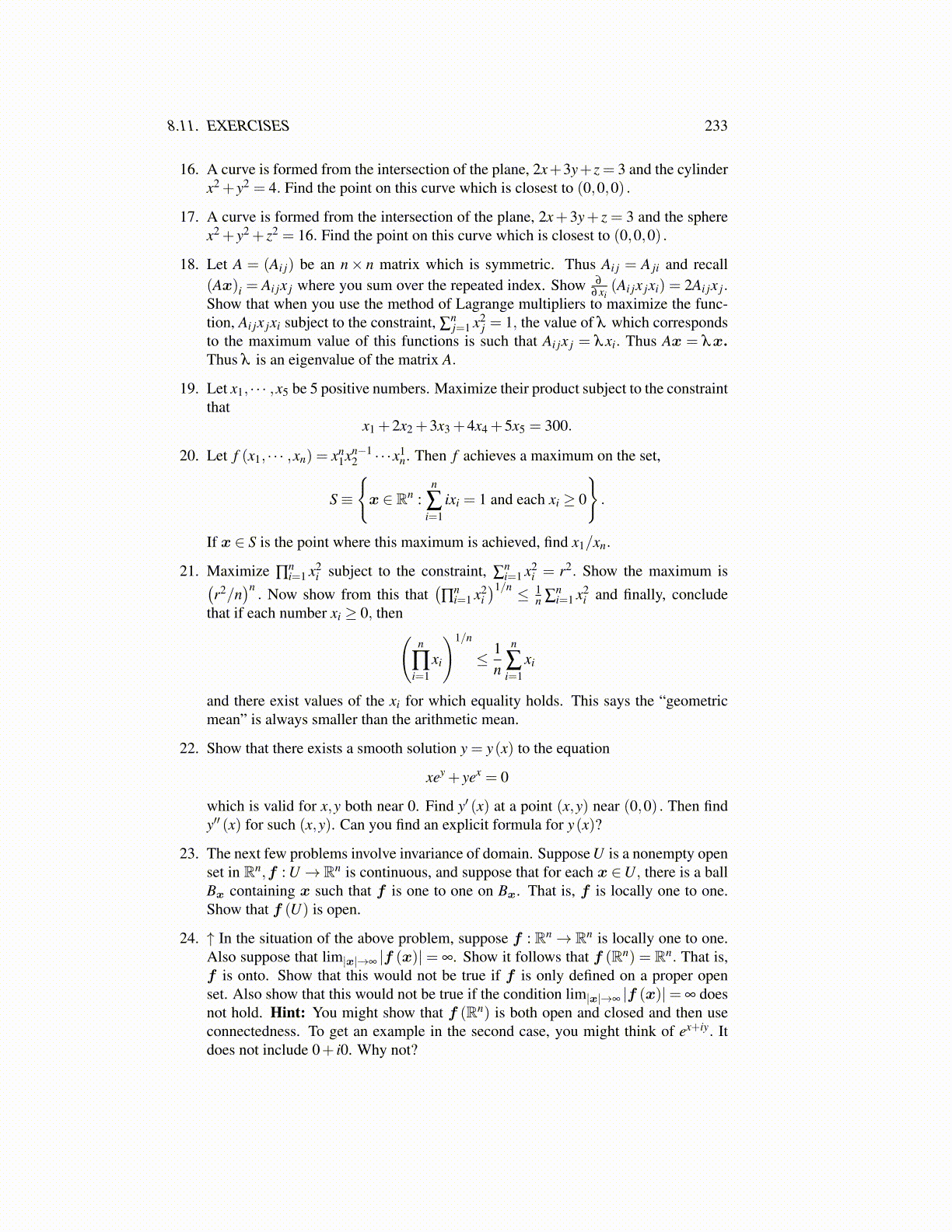
8.11. EXERCISES 233
16. A curve is formed from the intersection of the plane, 2x+3y+z = 3 and the cylinderx2 + y2 = 4. Find the point on this curve which is closest to (0,0,0) .
17. A curve is formed from the intersection of the plane, 2x+3y+ z = 3 and the spherex2 + y2 + z2 = 16. Find the point on this curve which is closest to (0,0,0) .
18. Let A = (Ai j) be an n× n matrix which is symmetric. Thus Ai j = A ji and recall(Ax)i = Ai jx j where you sum over the repeated index. Show ∂
∂xi(Ai jx jxi) = 2Ai jx j.
Show that when you use the method of Lagrange multipliers to maximize the func-tion, Ai jx jxi subject to the constraint, ∑
nj=1 x2
j = 1, the value of λ which correspondsto the maximum value of this functions is such that Ai jx j = λxi. Thus Ax = λx.Thus λ is an eigenvalue of the matrix A.
19. Let x1, · · · ,x5 be 5 positive numbers. Maximize their product subject to the constraintthat
x1 +2x2 +3x3 +4x4 +5x5 = 300.
20. Let f (x1, · · · ,xn) = xn1xn−1
2 · · ·x1n. Then f achieves a maximum on the set,
S≡
{x ∈ Rn :
n
∑i=1
ixi = 1 and each xi ≥ 0
}.
If x ∈ S is the point where this maximum is achieved, find x1/xn.
21. Maximize ∏ni=1 x2
i subject to the constraint, ∑ni=1 x2
i = r2. Show the maximum is(r2/n
)n. Now show from this that
(∏
ni=1 x2
i)1/n ≤ 1
n ∑ni=1 x2
i and finally, concludethat if each number xi ≥ 0, then(
n
∏i=1
xi
)1/n
≤ 1n
n
∑i=1
xi
and there exist values of the xi for which equality holds. This says the “geometricmean” is always smaller than the arithmetic mean.
22. Show that there exists a smooth solution y = y(x) to the equation
xey + yex = 0
which is valid for x,y both near 0. Find y′ (x) at a point (x,y) near (0,0) . Then findy′′ (x) for such (x,y). Can you find an explicit formula for y(x)?
23. The next few problems involve invariance of domain. Suppose U is a nonempty openset in Rn,f : U → Rn is continuous, and suppose that for each x ∈U, there is a ballBx containing x such that f is one to one on Bx. That is, f is locally one to one.Show that f (U) is open.
24. ↑ In the situation of the above problem, suppose f : Rn→ Rn is locally one to one.Also suppose that lim|x|→∞ |f (x)| = ∞. Show it follows that f (Rn) = Rn. That is,f is onto. Show that this would not be true if f is only defined on a proper openset. Also show that this would not be true if the condition lim|x|→∞ |f (x)|= ∞ doesnot hold. Hint: You might show that f (Rn) is both open and closed and then useconnectedness. To get an example in the second case, you might think of ex+iy. Itdoes not include 0+ i0. Why not?